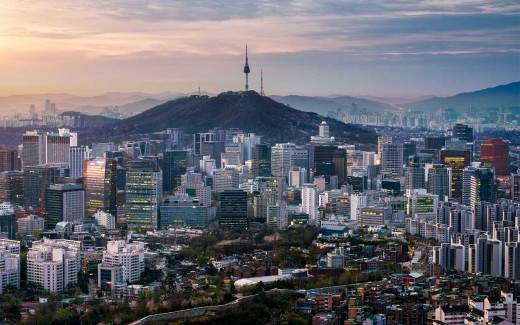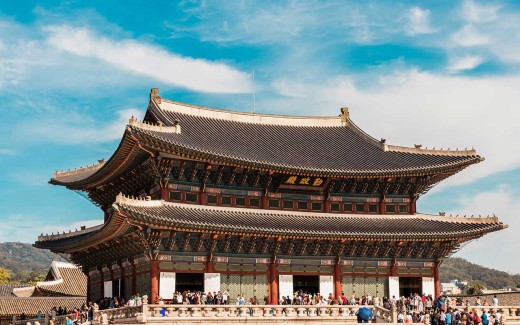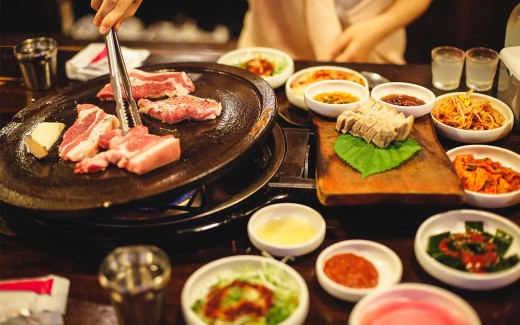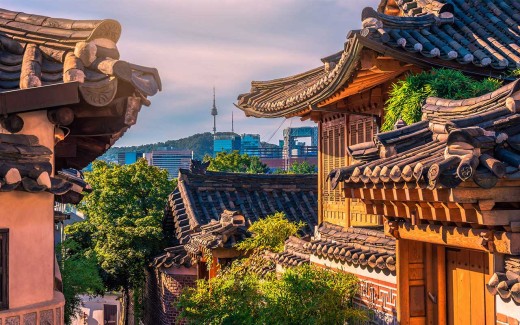Top 10 things to do in Seoul
1. Go up N Seoul Tower
Start your Seoul experience with a big view of the city from N Seoul Tower. Located on Namsan Mountain, the 236-metre transmission tower includes a roof terrace, digital observatory, several eating places and world-famous toilets with outrageous views. At night digital art is projected onto the tower. You can hike up to the tower or save your legs and catch the cable car - the three-minute trip starts on the northern flanks of the mountain. At the top of the cable car route is Namsan Beacon Mound, an ancient communication system used by government and militia. A re-enactment of how the Beacon Mound was used happens from 11.30 to 12.30 every day except Monday.
2. Explore the streets of Itaewon
The lively central city neighbourhood of Itaewon, right next to Namsan Mountain, is full of things to do, both touristy and non-touristy. Browse the antique shopping street, check out the War Museum of Korea, eat street food at Gwangjang Market, wander the trails of Namsan Botanical Garden and see the city from a rooftop bar. From early evening, catch some sounds at All That Jazz, the oldest jazz bar in Korea.
3. See old and new art at Leeum, Samsung Museum of Art
Seoul is great at hanging onto its past while embracing all things new. At the Leumm Samsung Museum of Art on the lower slopes of Namsan mountain you'll see a wonderful summary of Korean art, from ancient times to right now. You can also discover international works by artists like Andy Warhol, Damien Hirst and Jeff Koons. Museum 1, a fortress of terracotta bricks designed by Swiss architect Mario Botta, has four floors of ancient Korean art. Museum 2, a rusted stainless-steel structure design by French architect Jean Nouvel, showcases modern and contemporary art.
4. Appreciate Seoul's palaces
There are five royal palaces in Seoul, so you're never far from a palatial experience. Top billing usually goes to Gyeongbokgung Palace, first built in 1395. Beautiful in any season, this royal complex encompasses more than 300 buildings, including the National Folk Museum and The National Palace Museum. Other options for palace-gazing are Changdeokgung Palace, loved for its secret garden; Changgyeonggung Palace, a secondary royal residence. Deoksugung Palace, which includes British-style buildings, and Gyeonghuigung Palace, still undergoing restoration. If you want to get into a palace for free, dress in a hanbok (traditional Korean clothing). There are rental places near the palaces.


5. Feast on Korean food
Korean food is famously delicious and healthy. There's an emphasis on fresh ingredients and big flavours, and a total obsession with kimchi - the fermented cabbage and chilli condiment that goes with almost anything. Do some homework by watching the Netflix Street Food episode about Seoul to prepare for an onslaught of dumplings, knife-cut noodles, fried chicken, spicy rice cakes, Korean sausage, gimbap (rice and nori roles), twigim (tempura) and red bean waffles. The perfect accompaniment is makgeolli (sparkling rice wine), which has the status of craft beer in Korean. For a late night snack, look for pop-up food tents called pojanhmacha.
6. Discover Bukchon Hanok Village and Jongmyo Shrine
Not far from Gyeongbokgung Palace, Bukchon Hanok Village dates back to the 14th century. Its narrow streets are lined with restored traditional homes that once housed Joseon Dynasty officials and wealthy nobles. A quick bus ride from Bukchon Hanok Village is Jongmyo Shrine, one of the oldest and most authentic Confucian royal shrines in the world.


7. Investigate the ancient neighbourhood of Insadong
The neighbourhood of Insadong gives you a living glimpse of Seoul's past. Its cobbled streets are lined with traditional shops, family-run restaurants and art galleries. While you're wandering the tiny streets, keep an eye out for traditional tea houses, ceramics, masks and authentic street food, especially dumplings. Pause at Tapgol Park (Pagoda Park) to see its 10-story pagoda. An unforgettable discovery in eclectic Insadong is Ddong Café (aka Poop Café).
8. Shop for flavours and souvenirs at Namdaemun Market
With more than 10,000 vendors, Namdaemun Park is the largest traditional market in Korea. It's an amazing maze of indoor-outdoor stalls selling food, fashion, jewellery, clothing, luggage, toys, flowers, electronics and hiking gear. Highlights include non-stop street food, an entire street devoted to kids' clothes, affordable hanbok costumes and plenty of authentic souvenirs - fans, lamps and traditional hanji paper artworks.
9. Drop into the DMZ
From Seoul, the demilitarised zone (DMZ) is an easy 50km day trip. It's where South Korea meets North Korea - some tours actually take you to a room where you can stand in both countries at the same time. As you'd expect, the border is heavily guarded and the atmosphere is a bit tense. When Bill Clinton visited the DMZ in 1993 he called it the "scariest place on Earth." Most DMZ tours include unfinished infiltration tunnels, said to be built by the north; and the Freedom Bridge, used to return prisoners at the end of the war.
10. Hang out at Hwaseong Fortress
Less than an hour's train ride south of Seoul is Hwaseong Fortress, a magnificent landmark left over from Imperial Korea. Built in the 1700s to surround an entire city and protect the tomb of Prince Sado, the fortress is a UNESCO World Heritage Site that includes 5.5km of wall, entrance gates, a temple, palace and museum. While it has taken the knocks over the centuries, especially during the Korean War, Hwaseong remains one of South Korea's most significant historic sites.